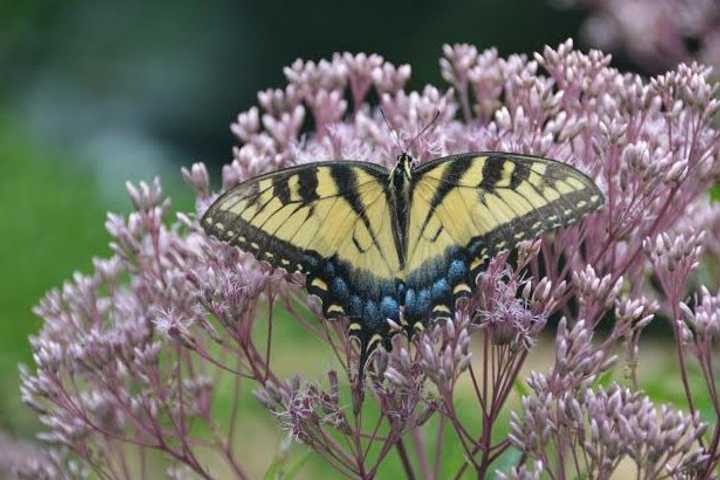Butterfly Bush, Buddleia davidii, is native to China where it has evolved with flora and fauna native to that country. Although Buddleia attracts many adult butterflies with its nectar, it does not support the caterpillars of our native and migrating butterflies.
Unlike their adult counterparts, most butterfly caterpillars have evolved to eat the leaves of just a few plant species – called host plants. Some host plants are quite showy, while some are “wilder” and best used in more natural areas. In some cases, caterpillars may rely upon just one type of plant which they must have to grow and make their wonderful metamorphosis into adults. This is the case with Monarch butterflies whose caterpillars only eat the leaves of Milkweeds (Asclepias species).
By planting Butterfly Bush, you draw in adult butterflies with enticing nectar, but then what? There is no host plant for the female butterfly to lay her eggs upon. Instinct tells the female not to lay eggs on any other plants. And so, no eggs, no caterpillars, no more adult butterflies. You have just created an ecological trap, where butterflies will come, but cannot create another generation of butterflies. This is especially devastating to species like the Monarch, which have declined dramatically over the past decade.
To attract and support generations of butterflies, you must include not only nectar plants, but native “host plants” in your landscape, many of which will also provide nectar to adult butterflies. Don’t worry, caterpillars only eat what they need -- you can enjoy the plants, as well.
Here is a sampling of butterflies found in our region, and some of their common host plants. You may be surprised by the number of trees and shrubs which support caterpillars.
Baltimore Checkerspot: Turtlehead Coral Hairstreak: Cherry, Plum, Chokecherry Eastern Comma: Elm, Nettle Eastern Tiger Swallowtail: Magnolias, Tulip Tree, Black Cherry Great Spangled Frittilary: Violets Hackberry Emperor: Hackberry Harris’ Checkerspot: Flat-topped White Aster Juniper Hairstreak: Eastern Red-cedar Meadow Frittilary: Violets Monarch: Milkweeds Mourning Cloak: Willows, Poplars, Birches, Hackberry, Elm Painted Lady: Mallows, Lupines, Thistles Pearl Crescent: Asters Pipevine Swallowtail: Dutchman’s Pipe (Pipevine) Red Admiral: Nettles Question Mark: Elm, Hackberry Spicebush Swallowtail: Spicebush, Sassafras Spring Azure: Dogwoods, Viburnums Zebra Swallowtail: Pawpaw
For more information on butterflies which are common to our region, their host plants and nectar plants, a great resource is www.butterfliesandmoths.org
Plant diversely, plant native, and be a good host to butterflies this year!
Kim Eierman, a resident of Bronxville, is an environmental horticulturist and Founder of EcoBeneficial! When she is not speaking, writing, or consulting about ecological landscapes, she teaches at the New York Botanical Garden, Brooklyn Botanic Garden, The Native Plant Center and Rutgers Home Gardeners School.
Click here to follow Daily Voice White Plains and receive free news updates.
